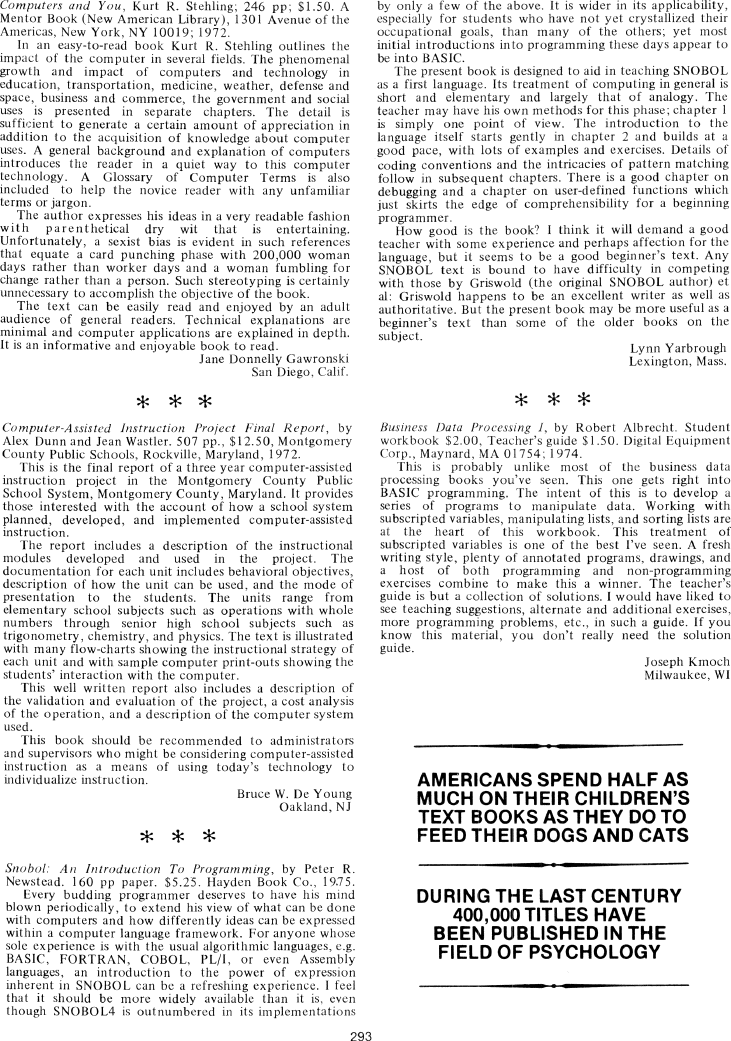The Best of Creative Computing Volume 1 (published 1976)
Computers and You (review, by Kurt R. Stehling, 1972)

Computers and You, Kurt R. Stehling; 246 pp; $1.50. A Mentor Book (New American
Library), 1301 Avenue of the Americas, New York, NY 10019; 1972.
In an easy-to-read book Kurt R. Stehling outlines the impact of the computer in
several fields. The phenomenal growth and impact of computers and technology in
education, transportation, medicine, weather, defense and space, business and
commerce, the government and social uses is presented in separate chapters. The
detail is sufficient to generate a certain amount of appreciation in addition to
the acquisition of knowledge about computer uses. A general background and
explanation of computers introduces the reader in a quiet way to this computer
technology. A Glossary of Computer Terms is also included to help the novice
reader with any unfamiliar terms or jargon.
The author expresses his ideas in a very readable fashion with parenthetical dry
wit that is entertaining. Unfortunately, a sexist bias is evident in such
references that equate a card punching phase with 200,000 woman days rather than
worker days and a woman fumbling for change rather than a person. Such
stereotyping is certainly unnecessary to accomplish the objective of the book.
The text can be easily read and enjoyed by an adult audience of general readers.
Technical explanations are minimal and computer applications are explained in
depth. It is an informative and enjoyable book to read.
Jane Donnelly Gawronski
San Diego, Calif,
***
Computer-Assisted Instruction Project Final Report, by Alex Dunn and Jean
Wastler. 507 pp., $12.50, Montgomery County Public Schools, Rockville, Maryland,
1972.
This is the final report of a three year computer-assisted instruction project
in the Montgomery County Public School System, Montgomery County, Maryland. It
provides those interested with the account of how a school system planned,
developed, and implemented computer-assisted instruction.
The report includes a description of the instructional modules developed and
used in the project. The documentation for each unit includes behavioral
objectives, description of how the unit can be used, and the mode of
presentation to the students. The units range from elementary school subjects
such as operations with whole numbers through senior high school subjects such
as trigonometry, chemistry, and physics. The text is illustrated with many
f1ow-charts showing the instructional strategy of each unit and with sample
computer print-outs showing the students' interaction with the computer.
This well written report also includes a description of the validation and
evaluation of the project, a cost analysis of the operation, and a description
of the computer system used.
This book should be recommended to administrators and supervisors who might be
considering computer-assisted instruction as a means of using today's technology
to
individualize instruction.
Bruce W. De Young
Oakland, NJ
Snobol: An Introduction To Programming, by Peter R. Newstead. 160 pp paper.
$5.25. Hayden Book Co., 19.75.
Every budding programmer deserves to have his mind blown periodically, to extend
his view of what can be done with computers and how differently ideas can be
expressed within a computer language framework. For anyone whose sole experience
is with the usual algorithmic languages, e.g. BASIC, FORTRAN, COBOL, PL/I, or
even Assembly languages, an introduction to the power of expression inherent in
SNOBOL can be a refreshing experience. I feel that it should be more widely
available than it is, even though SNOBOL4 is outnumbered in its implementations
by only a few of the above. It is wider in its applicability, especially for
students who have not yet crystallized their occupational goals, than many of
the others; yet most initial introductions into programming these days appear to
be into BASIC.
The present book is designed to aid in teaching SNOBOL as a first language. Its
treatment of computing in general is short and elementary and largely that of
analogy. The teacher may have his own methods for this phase; chapter 1 is
simply one point of view. The introduction to the language itself starts gently
in chapter 2 and builds at a good pace, with lots of examples and exercises.
Details of coding conventions and the intricacies of pattern matching follow in
subsequent chapters. There is a good chapter on debugging and a chapter on
user-defined functions which just skirts the edge of comprehensibility for a
beginning programmer.
How good is the book? I think it will demand a good teacher with some experience
and perhaps affection for the language, but it seems to be a good beginner's
text. Any SNOBOL text is bound to have difficulty in competing with those by
Griswold (the original SNOBOL author) etal: Griswold happens to be an excellent
writer as well as authoritative. But the present book may be more useful as a
beginner's text than some of the older books on the subject.
Lynn Yarbrough
Lexington, Mass.
***
Business Data Processing I, by Robert Albrecht. Student workbook $2.00,
Teacher's guide $1.50. Digital Equipment Corp., Maynard, MA 01754; 1974.
This is probably unlike most of the business data processing books you've seen.
This one gets right into BASIC programming. The intent of this is to develop a
series of programs to manipulate data. Working with subscripted variables,
manipulating lists, and sorting lists are at the heart of this workbook. This
treatment of subscripted variables is one of the best I've seen. A fresh writing
style, plenty of annotated programs, drawings, and a host of both programming
and non-programming exercises combine to make this a winner. The teacher's guide
is but a collection of solutions. I would have liked to see teaching
suggestions, alternate and additional exercises, more programming problems,
etc., in such a guide. If you know this material, you don't really need the
solution guide.
Joseph Kmoch
Milwaukee, WI
AMERICANS SPEND HALF AS MUCH ON THEIR CHILDREN'S TEXT BOOKS AS THEY DO TO FEED
THEIR DOGS AND CATS
DURING THE LAST CENTURY 400,000 TITLES HAVE BEEN PUBLISHED IN THE FIELD OF
PSYCHOLOGY
293


